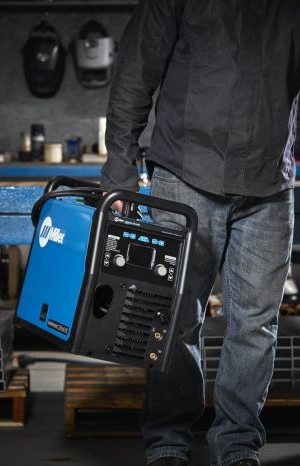With huge rebates on both the Lincoln Power MIG 210 MP and Multimatic 215, people want to know how these two welders stack up. Both machines offer the ability to Stick, MIG or TIG weld, but which one does it better?
Why multi-process machines?
In determining which machine is best for you, ask yourself, “why do I want a multi-process machine?” These wonders of the modern world are as revolutionary as combining a cellphone, GPS and camera together. You get the 3 most common processes for about the price of one machine (especially with this great rebate which brings the cost in around the price of a dedicated MIG or TIG machine).
Another benefit is the portability and small amount of space a multi-process machine takes up compared to having 3 separate machines. It’s perfect for welders who plan on traveling with their machine or don’t have a large workshop to store all their equipment. Anyone who needs a combination of Stick, TIG and MIG to make repairs will instantly recognize how much easier a multi-process machine is. It’s perfect for farm welders or jeep/truck welders who need to make portable repairs that might require either Stick, MIG or TIG depending on the issue.
Mobility and small-size are two of the Multimatic 215’s main selling points. At 38 pounds, you won’t find a lighter multi-process machine. It’s also incredibly small, making it super easy to throw in the trunk of any car or carry around under your arm.
Interestingly, the Power MIG 210 places more of an importance on being rugged and tough rather than portability, despite the fact it only weighs 2 pounds more than the Multimatic 215. As far as size goes, the Power MIG 210 is taller than the Multimatic 215 but still easily fits under your arm or in the trunk of a car.
What’s the difference?
A lot of welders will say the only difference between the Miller Multimatic 215 and the Lincoln Power MIG 210 is the color. And in some respects, they would be correct. Miller and Lincoln have been locked in a head-to-head competition with these 2 machines, meaning both companies work around the clock to make sure their machine is at least as good as the other. But there are a few key differences.
As the name suggests, the Power MIG 210 can get up to 210 amps with a 240 volt plug. Deciding they wanted to break from the name game, the newest version of the Multimatic 215 actually can go as high as 230 amps, not 215. While that extra bit of power can make a difference, both machines limit their claims to how thick of material you can cut at 3/8” thick mild steel with a single pass.
The Multimatic 215 comes with Miller’s array of user-friendly features to make your life easy. This includes the invaluable auto-set elite feature, smooth start, angle wire drive and thermal overload protection (for those of you who don’t pay attention to duty cycle).
While the Power MIG 210 does have some user-friendly features of its own, Lincoln has chosen to promote the price of the Power MIG 210. Right now you can get the Lincoln Power MIG 210 MP for $999 after rebate. The Multimatic 215 costs $1,265 after rebate.
In the end, you’ll have to decide which machine is better for you. Luckily, you can’t really go wrong either way. But if you’re used to Miller’s array of user-friendly tools, the extra cost is well worth it. And if you’re a Lincoln veteran, you can use that extra dough to pick up the Aluminum One-Pak for the Power MIG which allows you to weld aluminum right out of the box via the spool gun included in the kit. For more details about each of these machines, click their images below.
IMPORTANT NOTE: Since both machines are DC TIG only, you cannot TIG weld aluminum. If that’s a deal breaker, check out the Miller Multimatic 220 that can TIG weld aluminum.








